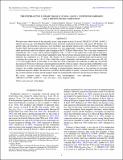| dc.contributor.author | Burgasser, Adam J. | |
| dc.contributor.author | Sitarski, Breann N. | |
| dc.contributor.author | Gelino, Christopher R. | |
| dc.contributor.author | Logsdon, Sarah E. | |
| dc.contributor.author | Perrin, Marshall D. | |
| dc.date.accessioned | 2015-03-27T18:14:27Z | |
| dc.date.available | 2015-03-27T18:14:27Z | |
| dc.date.issued | 2011-09 | |
| dc.date.submitted | 2011-05 | |
| dc.identifier.issn | 0004-637X | |
| dc.identifier.issn | 1538-4357 | |
| dc.identifier.uri | http://hdl.handle.net/1721.1/96228 | |
| dc.description.abstract | We report new observations of the unusually active, high proper motion L5e dwarf 2MASS J13153094–2649513. Optical spectroscopy with Magellan/MagE reveals persistent nonthermal emission, with narrow H I Balmer, Na I and K I lines all observed in emission. Low-resolution near-infrared spectroscopy with the Infrared Telescope Facility/SpeX Spectrograph indicates the presence of a low-temperature companion, which is resolved through multi-epoch laser guide star adaptive optics imaging at the W. M. Keck Observatory. The co-moving companion is separated by 338 ± 4 mas, and its relative brightness (ΔKs = 5.09 ± 0.10) makes this system the second-most-extreme flux ratio very-low-mass binary identified to date. Resolved near-infrared spectroscopy with Keck/OSIRIS identifies the companion as a T7 dwarf. The absence of Li I absorption in combined-light optical spectroscopy constrains the system age to gsim0.8-1.0 Gyr, while the system's kinematics and unusually low mass ratio (M 2/M 1 = 0.3-0.6) suggest that it is even older. A coevality test of the components also indicates an older age, but reveals discrepancies between evolutionary and atmosphere model fits of the secondary, which are likely attributable to poor reproduction of its near-infrared spectrum. With a projected separation of 6.6 ± 0.9 AU, the 2MASS J1315–2649 system is too widely separated for mass exchange or magnetospheric interactions to be powering its persistent nonthermal emission. Rather, the emission is probably chromospheric in nature, consistent with an inversion in the age-activity relation in which strong magnetic fields are maintained by relatively old and massive ultracool dwarfs. | en_US |
| dc.description.sponsorship | United States. National Aeronautics and Space Administration | en_US |
| dc.description.sponsorship | National Science Foundation (U.S.) | en_US |
| dc.language.iso | en_US | |
| dc.publisher | Institute of Physics/American Astronomical Society | en_US |
| dc.relation.isversionof | http://dx.doi.org/10.1088/0004-637x/739/1/49 | en_US |
| dc.rights | Article is made available in accordance with the publisher's policy and may be subject to US copyright law. Please refer to the publisher's site for terms of use. | en_US |
| dc.source | American Astronomical Society | en_US |
| dc.title | THE HYPERACTIVE L DWARF 2MASS J13153094–2649513: CONTINUED EMISSION AND A BROWN DWARF COMPANION | en_US |
| dc.type | Article | en_US |
| dc.identifier.citation | Burgasser, Adam J., Breann N. Sitarski, Christopher R. Gelino, Sarah E. Logsdon, and Marshall D. Perrin. “THE HYPERACTIVE L DWARF 2MASS J13153094–2649513: CONTINUED EMISSION AND A BROWN DWARF COMPANION.” The Astrophysical Journal 739, no. 1 (September 6, 2011): 49. © 2011 American Astronomical Society. | en_US |
| dc.contributor.department | MIT Kavli Institute for Astrophysics and Space Research | en_US |
| dc.contributor.mitauthor | Burgasser, Adam J. | en_US |
| dc.relation.journal | Astrophysical Journal | en_US |
| dc.eprint.version | Final published version | en_US |
| dc.type.uri | http://purl.org/eprint/type/JournalArticle | en_US |
| eprint.status | http://purl.org/eprint/status/PeerReviewed | en_US |
| dspace.orderedauthors | Burgasser, Adam J.; Sitarski, Breann N.; Gelino, Christopher R.; Logsdon, Sarah E.; Perrin, Marshall D. | en_US |
| mit.license | PUBLISHER_POLICY | en_US |
| mit.metadata.status | Complete | |
